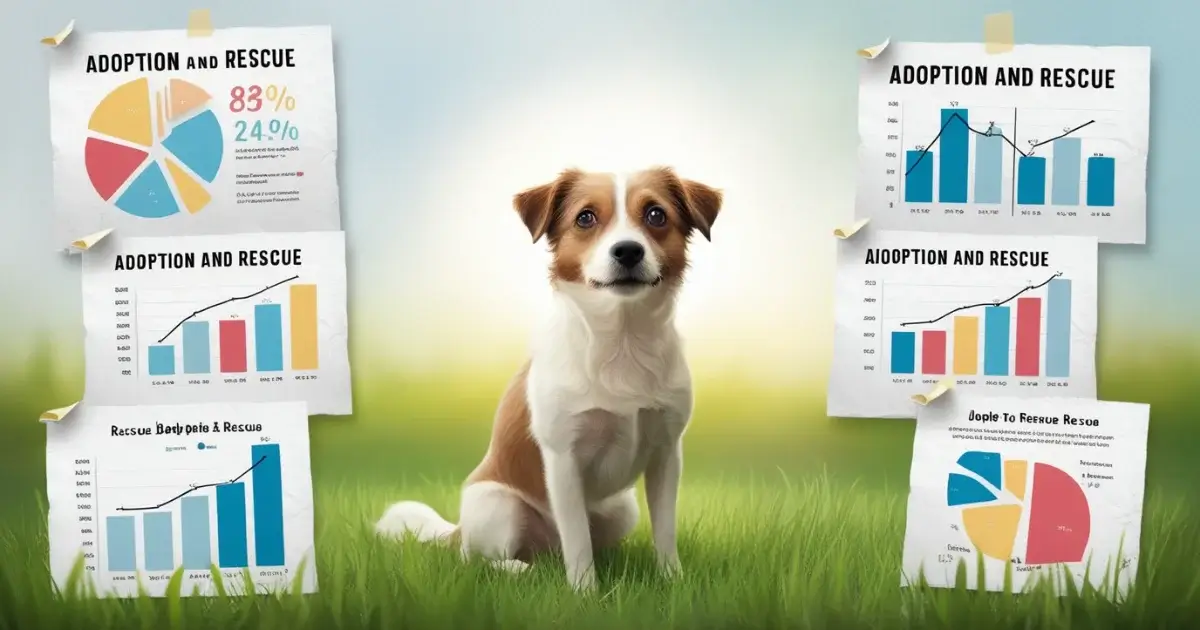Comprehensive Dog Adoption and Rescue Data Statistics 2025
Every year, millions of dogs enter shelters, each with a story waiting for a happy ending. Shelters and rescue organizations work tirelessly to give these animals a second chance. By analyzing dog adoption and rescue data, we gain valuable insights into adoption trends, challenges, and inspiring success stories. This guide breaks it all down, offering hope and encouragement for a better future.
Table of Contents
Understanding Shelter Dog Adoption Rates in the USA
The Current State of Shelter Intakes and Adoptions
In 2024, 12 million dogs entered shelters across the United States. While this reflects a slight increase from the previous year, the progress in adoption efforts is encouraging. Approximately 2 million dogs are adopted annually, showcasing the commitment of shelters and adopters to reducing overcrowding and giving these animals loving homes.

Trends Over the Last Decade
There have been significant improvements in shelter management over the past decade. Back in 2011, 3.9 million dogs entered shelters annually, but today, that number has dropped significantly. The number of dogs euthanized each year has also decreased, from 2.6 million in 2011 to 390,000 today. This progress is largely due to better adoption rates and increased efforts to reunite stray animals with their families.
Key Factors Influencing Adoption Rates
Several factors contribute to adoption successes:
- Stray animal returns: Each year, 810,000 stray animals are reunited with their owners, with 710,000 being dogs.
- Breed preferences: Mixed breeds account for 54% of adopted dogs, while 25% of shelter dogs are purebreds. Highlighting the value of mixed breeds helps drive adoption rates higher.
Rescue Dog Data USA: Insights and Challenges
Rescue Organization Contributions
Organizations like the ASPCA, Humane Society, and smaller rescues have made a huge difference. They provide medical care, foster programs, and adoption services. Despite their success, many challenges remain, including limited resources and overcrowded shelters. Still, their work ensures millions of dogs find safety and love.
Regional and Breed-Specific Adoption Trends
Adoption rates vary by region. Urban areas often see higher shelter dog adoption rates due to better resources and outreach programs. Certain breeds, such as Golden Retrievers and Labradors, are frequently adopted. However, other breeds, often due to misconceptions or lack of awareness, face longer shelter stays.
The Problem of Black Dog Syndrome
Black Dog Syndrome is a phenomenon where black dogs are adopted less frequently. This bias stems from misconceptions and preferences. Many shelters have launched campaigns to combat this, showcasing the loving and loyal nature of these overlooked dogs.
Stray Dog Population Worldwide: A Growing Concern
Global Statistics on Stray Dogs
The World Health Organization estimates over 200 million stray dogs worldwide. This staggering number highlights the need for global efforts to manage stray populations.
Causes of Increasing Stray Populations
Stray populations grow due to:
- Abundant food and shelter in urban areas.
- Lack of spay/neuter programs, especially in developing regions. Without sterilization efforts, stray populations increase rapidly.
Solutions to Mitigate the Stray Dog Crisis
To address these issues:
- Community-based spay/neuter programs help control reproduction humanely.
- Partnerships between governments, NGOs, and communities ensure sustainable solutions.
- Public education campaigns encourage responsible pet ownership and sterilization.
Ethical and Ecological Implications
Stray dogs impact urban ecosystems, sometimes posing risks to wildlife or public safety. Ethical approaches to controlling these populations create better outcomes for both animals and communities.
Inspiring Pet Rescue Success Stories
Heartwarming Adoption Tales
Rescue stories often warm hearts and inspire action. One such story is Max, a senior dog adopted after years in a shelter. His new family shared how he brought joy and companionship to their lives. Stories like Max’s highlight the transformative power of adoption.
Role of Social Media in Promoting Adoptions
Social media has revolutionized pet adoption. Viral campaigns showcasing pet rescue success stories help shelters find homes for dogs faster. Platforms like Instagram and Facebook bring global attention to rescue efforts, increasing adoptions and donations.

Testimonials from Adoptive Families
Adoptive families often emphasize how much joy their dogs bring. One family shared: “Adopting Bella changed our lives. Her love and loyalty brighten our days.” Such testimonials inspire others to choose adoption over purchasing.
The Economics of Dog Adoption and Rescue
Costs Associated with Adopting a Dog
Adoption fees typically range from $50 to $300. This covers vaccinations, spaying/neutering, and microchipping. Adopting is not only affordable but also saves lives.
Economic Benefits of Rescue Efforts
Rescue efforts reduce public expenses. Fewer strays mean less money spent on animal control services and public health concerns. Supporting these efforts benefits everyone.
How You Can Support Dog Adoption and Rescue Efforts
Volunteering and Donations
You can make a difference by volunteering at shelters or donating to rescue organizations. Even sharing adoption events or success stories on social media can help.
Advocating for Policy Changes
Advocacy matters. Supporting stricter spay/neuter laws and improved breeding regulations reduces overpopulation and helps more dogs find homes.
Key Statistics at a Glance
| Statistic | Value |
| Dogs entering U.S. shelters annually | 3.2 million (2025) |
| Annual dog adoptions | 2 million |
| Strays returned to owners | 710,000 (dogs) |
| Global stray dog population | 200 million |
| Adoption fees | $50 – $300 |
Conclusion
Dogs adoption and rescue data show how far we’ve come—and how far we still have to go. By adopting, volunteering, or advocating, you can help save lives and create brighter futures for shelter dogs. Together, we can make a difference—one adoption at a time.
FAQs
How is the stray dog population worldwide managed?
The stray dog population worldwide is managed through spay/neuter programs, public education, and partnerships between governments and NGOs. These efforts focus on humane solutions to control stray populations and ensure community safety.
What role do rescue organizations play in pet adoptions?
Rescue groups, such as the ASPCA, focus on fostering, rehabilitating, and promoting rescue dog data USA. They organize adoption events, provide medical care, and connect animals with loving families.
Why are black dogs harder to adopt?
Black Dog Syndrome is a bias where black-coated dogs are less adopted due to superstition or poor visibility in photos. Awareness campaigns now promote their adoption, improving their chances for homes.
How can social media improve pet rescue success stories?
Social media showcases pet rescue success stories, raising awareness and boosting adoptions. Platforms like Instagram highlight rescued animals’ transformations, motivating people to adopt or donate to shelters.







